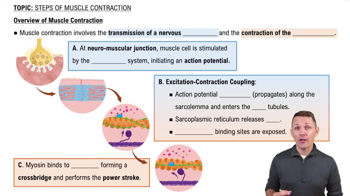Here are the essential concepts you must grasp in order to answer the question correctly.
Acetylcholinesterase Function
Acetylcholinesterase is an enzyme that breaks down the neurotransmitter acetylcholine in the synaptic cleft after it has activated muscle cell receptors. This process is crucial for terminating the signal that triggers muscle contraction, allowing the muscle to relax and preventing continuous stimulation.
Recommended video:
Neuromuscular Junction
The neuromuscular junction is the synapse or connection point between a motor neuron and a muscle fiber. At this junction, acetylcholine is released from the neuron, binds to receptors on the muscle cell, and initiates a series of events leading to muscle contraction. The role of acetylcholinesterase here is vital for controlling the timing and duration of muscle contractions.
Recommended video:
A. Events at the Neuromuscular Junction
Muscle Contraction Mechanism
Muscle contraction occurs through a process called excitation-contraction coupling, where an electrical signal from the motor neuron leads to the release of calcium ions within the muscle cell. These calcium ions interact with proteins in the muscle fibers, enabling contraction. Acetylcholinesterase ensures that the contraction is brief and controlled by rapidly degrading acetylcholine, thus allowing the muscle to return to its resting state.
Recommended video:
Overview of Muscle Contraction
 Verified step by step guidance
Verified step by step guidance


